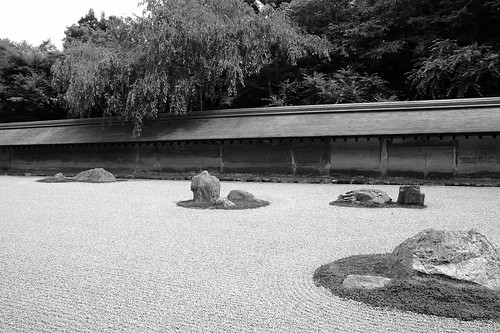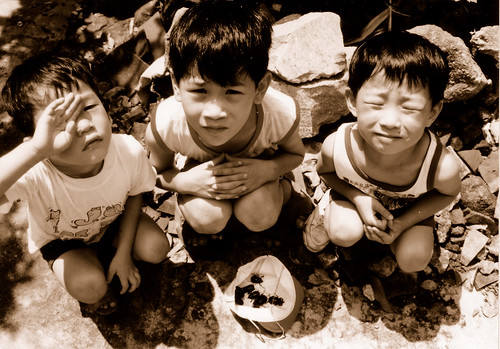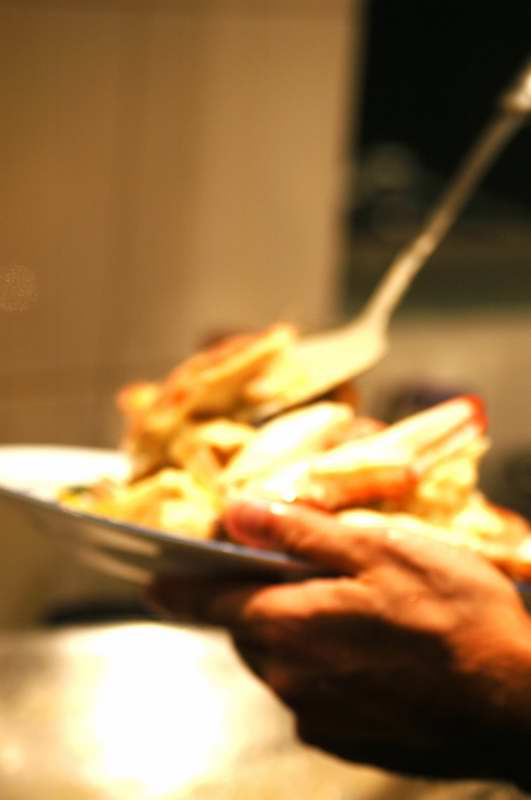Red, hot and steamy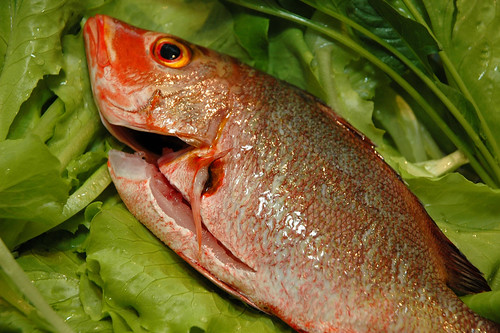
Loooooooooong time!
This fish is one of the best I’ve ever had. It’s not an uncommon species. Yet, I have only seen it twice in the market. I believe it is well sought after by the Japanese (for sashimi). Not really sure about its name in English. We call it “Red Rooster” (海紅雞) in China and Taiwan.
Fishes like this should never be overcooked. To take it to the frying pan, grill or hot oil is a crime. Don’t even think about doing it. To retain its freshness and tenderness, all we have to do is to give it a quick easy steam – the traditional Chinese way.
This fish was live when I found it in the market. Here in Hong Kong, about half of the fishes are kept live when they are sold. There’s a huge difference, however, between live fishes from the sea and those from the farm. This species cannot be grown in the farm. Finding a live one is a challenge.
This fish weighs about ½ kg – just perfect. Anything smaller, you won’t get enough to taste. Bigger, its delicacy will diminish.
Rinse it thoroughly and leave it dry for 5-10 minutes. Use a kitchen towel to mop it up a little, if necessary.
Have coriander and spring onion ready. Wash them well and leave them all dry. Chop them finely just before use. Ginger is optional and should be chopped finely also.
Bring water to a full boil. Use a heavy lid if possible, because steam must be intense enough so that the fish can be just cooked within the shortest span of time. That’s the key about Chinese steam fish. It’s very straightforward but often easily overlooked.
For a fish as small as this, 5 minutes are all it needs. While it’s in the steam, start heating up half a spoonful of peanut oil. Add ginger when oil is hot.
Take the fish out immediately when done. Sprinkle it with coriander and spring onion. Pour oil and ginger instantly and evenly on the surface. Give it drops of soy-sauce (preferably hot) and a quick grind of fresh white-pepper.
Any white wine goes well with this fish. Pick one that is a little dry on the edge, to help your taste buds uncover the delicacy of this rare species.
Sunday, April 26, 2009
Friday, August 22, 2008
Wednesday, August 06, 2008
Pourquoi que je vis
Pourquoi que je vis
Pour la jambe jaune
D'une femme blonde
Appuyée au mur
Sous le plein soleil
Pour la voile ronde
D'un pointu du port
Pour l'ombre des stores
Le café glacé
Qu'on boit dans un tube
Pour toucher le sable
Voir le fond de l'eau
Qui devient si bleu
Qui descend si bas
Avec les poissons
Les calmes poissons
Ils paissent le fond
Volent au-dessus
Des algues cheveux
Comme zoizeaux lents
Comme zoizeaux bleus
Pourquoi que je vis
Parce que c'est joli

Saturday, April 05, 2008
Tagliatelle al Gamberetti e Calamari
The first impression I had about pasta was from Pizza Hut. Obviously not a nice experience to start with. Then I tried cooking my own with a bottle of Dolmo spaghetti sauce. Very soon I began wondering why people would eat pasta in the first place. I was convinced that Marco Polo must have got things upside down when he brought home that nest of Chinese noodles. Until I tried the authentic Italian pasta (somewhere in Italy, of course), I didn’t realize I'd been so wrong and missed out the whole truth about this five-letter word.
Cooking pasta is all about time, nothing more or less. Ingredients are simple and few. To get that “al dente” quality, you must get the timing unforgivingly right. The most critical part of the cooking process lasts for just about five minutes. You can either glorify or ruin it in five minutes!
This recipe is similar to the one I did here in October 2006, Tagliatelle al Cappesante con Basilico. I only have the scallops replaced by prawns and squids, and white Shimeji mushrooms instead of brown. They are the best choices of ingredient for making seafood pasta, in my experience. Get those medium-sized sea prawns with rich roes inside their heads. They offer an excellent natural ingredient for the sauce. You’ll also get that golden-red color that will drive your appetite up to the roof.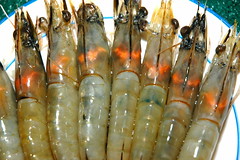 Ingredients, for a single serving:
Ingredients, for a single serving:
1. 2 nests of tagliatelle (fresh is better, but dried just fine);
2. sea prawns with rich roes;
3. fresh squids;
4. white Shimeji mushrooms;
5. 2 cloves of garlic, finely chopped;
6. 1 small cube of Parmigiano Reggiano cheese; and of course
7. a bunch of fresh basil.
Remove the shells of the prawns. Slice them gently on the top and get their intestines out (be careful not to squeeze their roes out!). Clean the squids, remove their skins, and slice them diagonally from top to bottom to get thinner layers.
Bring tagliatelle to a fast boil and add sea-salt for 4 minutes. Leave the lid open and stir occassionally.
Heat up the pan with garlic and extra virgin olive oil. I have found a Berndes 12-inch wok an excellent equipment for cooking this pasta. It adds a dose of “Chinese wok-spirits” to the final outturn.
Bring the prawns, squids and a bit of butter in. Let them simmered in medium heat for ½ minute. Bring in the Shimeji mushrooms and stir them all gently for another minute.
The tagliatelle should be done and drained by now (don’t rinse with cold water). Pour it over the prawns and squids. Stir-fry them gently altogether for one more minute in high-medium heat.
Lower the heat to medium. Grind some white-and-black pepper and half a cube of Parmigiano Reggiano. Turn off the heat. Give it another gentle stir.
Bring everything onto a warm plate. Garnish generously with fresh Italian basil. A few more drops of extra olive oil, another grind of pepper and it’s done. A glass of Chardonnay will promise to make this pasta sing!
Labels: recipe
Saturday, March 22, 2008
Grilled Sardine Chinese Style
It is very unusual to find a live one-feet long sardine in the local market here. This sardine was an absolute beauty - bright colors and thick trunk. I knew instantly this would make a beautiful dinner.
Sardines are named after the island of Sardinia, where they were once found in abundance. Found in shoals throughout the Atlantic and Mediterranean, sardines have a silver skin and a rich-flavoured flesh that is dark in colour. Sardines are common also in the Pacific seas. However, they do not find their place in the Chinese cooking culture. The Chinese always prefer steamed fishes. Steaming a sardine does not produce good results. It's probably why local fishermen don't often catch them, and they are cheap in our market.
According to Wikipedia, sardines play an important role in Portuguese culture. Having been a people who depended heavily on the sea for food and commerce, the Portuguese have a predilection for fish in their popular festivities. The most important is Saint Anthony's day, 13th June, when the biggest popular festival takes place in Lisbon, taking the people to the streets where grilled sardines are the snack of choice. Almost every place in Portugal, from Figueira da Foz to Portalegre, or from Póvoa de Varzim to Olhão has the summertime popular tradition of eating grilled sardines. In Macau (45 minutes on a ferry from Hong Kong), sardines are easily available due to the Portugese influences. Traditional Portugese or Macanese restaurants always serve grilled sardines or mackerels.
This time however I'm going to add a little twist to the traditional recipe, by bringing a considerable balance of Chinese elements.
The ingredients - always as minimal as they can be:
1. a whole fresh sardine, keeping its head and tail intact;
2. slices of ginger, finely shredded;
3. two garlic gloves, finely chopped not crushed;
4. a handful of coriander, chopped; and
5. extra-virgin olive oil and extra-virgin soya-sauce.
Marinate the sardine with a splash of extra-virgin olive oil, sea-salt, ground pepper, ginger, garlic and a gentle touch of flour, preferably for an hour or two.
Heat up the pan to a grilling temperature. Toss the sardine onto the pan, lower the temperature slightly and leave one side grilled for about 5 minutes. Keep it still and don't try to move it while it's being cooked.
Turn around the fish and give it another 4 minutes. Quickly move it to a warm plate. Garnish the fish with coriander on top, and sprinkle more extra-virgin olive oil. Last but not least, a nice gentle splash of extra-virgin soya-sauce and one last grind of black-and-white pepper! Best served with a bottle of young sauvignon blanc or riesling!
Labels: recipe
Saturday, March 08, 2008
Strawberry-banana Crepes
Simple, fresh ingredients. A cupful of cappuccino. A straight 15-minute labour for a whole sunday afternoon.
Ingredients:
1. one egg;
2. 3/4 cup of milk;
3. 1/2 cup of flour;
4. strawberry, banana, maple syrup and vanilla ice-cream.
Beat egg, milk, flour and a bit of water in a mixing bowl. To keep the crepes thin, the mix should be quite waterly - never sticky. Melt a teaspoon of butter on a frying pan. Lift and tilt pan to keep the butter coated evenly over the pan. Use a tiny piece of kitchen towel to spread it when necessary.
Turn up the heat. Pour in the batter and let it spread thinly and evenly over the pan. Cook until top appears dry; turn and cook 15-20 seconds longer.
Repeat with remaining batter, adding butter to the pan as needed. Slice banana and strawberry into shapes of your choice. Spread them all over the crepes. Add a scoop of vanilla ice-cream. A few drops of maple syrup in a final touch.

Labels: recipe
Sunday, March 02, 2008
Vietnamese Sausages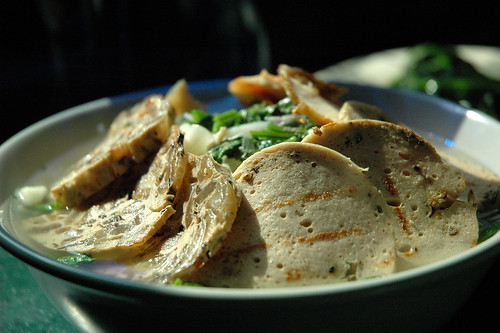
I have to change my opinion about Vietnamese sausages. Never tried the authentic Vietnamese sauages until GM5 gave me two rolls. She brought them all the way from Vietnam. Wrapped in banana leaves, they were incredibly fresh and full of texture and nuances. The sausages I find here in Hong Kong are all frozen, MSG-contaminated and taste uninspiring.
I sliced them thin and pan-grilled them for a minute or so. Vermicelli and veggeis were prepared in chicken broth at the same time. A straight 15-minute labour. The key is of course finding those sausages.
Labels: recipe
Wednesday, January 02, 2008
A Minimalist Approach to Make a Singaporean Laksa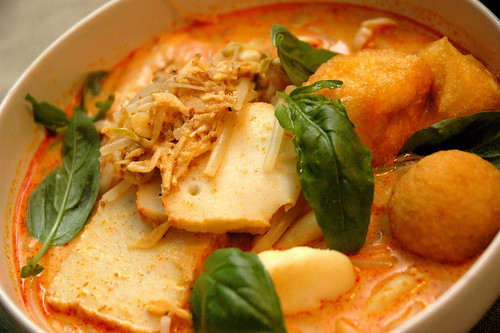
I spent two days in Singapore just before Christmas. It wasn't for holiday though. Things were fairly tight. I didn't have time enough to venture beyond the area I was staying. But there's one thing I have always tried to accomplish - shop for the most exotic cooking ingredients and bring them home.
I've been to Singapore many times. The best foods there are found not at the restaurants but the local food or hawker centers. Cheap, nice, clean, unflattering and unpretentious. Laksa, bak kut teh (pork rib tea), Hokkien fried noodles, Hainanese chicken, to name but a few.
This time I brought home with bags of laksa paste, among other things (some were confiscated at the airport, unfortunately). On the Boxing Day, I invited my friends/neighbours to come around and try.
Laksa is a popular spicy noodle soup from Peranakan culture, which is a merger of Chinese and Malay elements found in Malaysia and Singapore. I have tried the laksa from both locations. And honestly I find the Singaporean laksa better (don't ask me why).
The origin of the name "laksa" is unclear. The name may originate from the Sanskrit word laksha (लक्ष), meaning "many" (in modern Hindi, lakh, or 100,000) and referring to the soup's countless ingredients (including dried chillies, purple ginger, yellow ginger, lemon grass, candlenuts, dried prawns, shallots and garlic). Another proposition traces it back to Hindi/Persian lakhshah, referring to a type of vermicelli.
Because this thing is made with so many of such and such ingredients, it's obviously against the principles of this blog. Nevertheless, the author of this blog loves it so much that he feels obliged to be a little more innovative. To save the trouble of bringing those thousand ingredients together, I have gone to search for a single laksa paste that can do the magic and, at the same time, must be made from non-artificial ingredients. After rounds of attempts, I have found this particular one from Singapore. It contains no preservatives and MSG (and hence has to be consumed within weeks from purchase). It has 4 to 5 servings in a pack. So I rounded up a few buddies for a spicy Christmas experience.
The ingredients - sorry, still quite many:
1. one packet of XXX'X laksa paste;
2. 1/3 litre of coconut milk;
3. dried shrimps;
4. vermicelli or flat rice-noodles;
5. whole sea prawns;
6. squid balls;
7. fish cake, sliced;
8. boiled eggs, shell removed and sliced;
9. fried beancurds;
10. a bunch of white shimeji mushrooms;
11. a bunch of beansprouts; and
12. Thai basil for garnishing.
Cook vermicelli first, rinse well and leave it well drained. Bring 3 to 4 bowls of water and laksa paste into boil, followed by coconut milk and dried shrimps. Add a teaspoonful of sea-salt and cook over low heat for 2 minutes until goldenly fragrant.
Bring the soup to high heat. Throw in prawns, squid balls, fish cake and mushrooms first for 2 minutes, followed by beancurds and beansprouts for another minute.
Vermicelli now sits ready in the bowl. Pour the soup and everything in. Place the eggs on top, garnish with Thai basil (always!), and it's done. Best served with a cold malt or white beer!
Labels: recipe
Saturday, November 10, 2007

Labels: sight
Friday, July 20, 2007
I don't remember when I started taking squid ink seriously. Squids are quite popular in our Chinese cooking culture. Deep-fry with salt and pepper, stir-fry with black beans and chillies, steam with garlic and ginger, etc, etc. But no one would ever think of cooking and eating their ink. It is something considered dirty and hideous in our culture.
I know it's an idea from the Europeans but still don't know exactly who started turning squid ink into a cooking ingredient. I suppose it was the Spaniards or the Italians. I have also heard, in Venice, this squid ink risotto is one of their hallmark dishes.
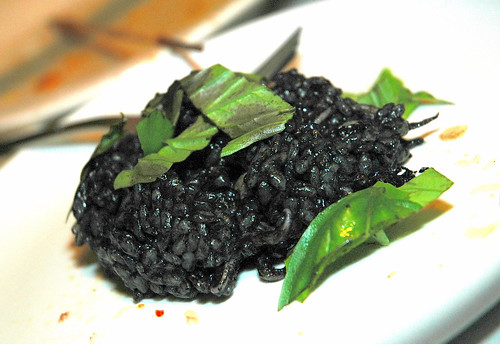 I was deeply attracted by the blackness of this "gravelly tar" and, given my madness about pasta and risotto, I decided to give it a play in my kitchen. My recipe is somewhat different from the traditional one, keeping it simple and easy. And all ingredients can be found in this part of the world.
I was deeply attracted by the blackness of this "gravelly tar" and, given my madness about pasta and risotto, I decided to give it a play in my kitchen. My recipe is somewhat different from the traditional one, keeping it simple and easy. And all ingredients can be found in this part of the world.1. 1/2 kg of whole fresh squids or cuttlefishs;
2. 1 garlic clove, finely chopped;
3. 2 cups of Japanese short-grain sushi rice, leaving it dry;
4. 1/2 litre of boiling fish or chicken broth;
5. a crown of white Shimeji mushrooms;
6. 1 cube of Parmigiano Reggiano, grated; and
7. a handful of basil, finely chopped.
Get those baby squids if you can. They are the best. Clean the squids by removing eyes, beak and transparent quill. Remove and reserve the ink sac. It can break easily. So be extra gentle with it.
You may peel off the skin too, but I'll just leave it if the squids are fresh enough. Cut them into strips or cubes. Rinse the mushrooms and chop them also into small cubes.
Heat up a small cooking pot with extra virgin olive oil. Toss rice and garlic into the pot (I don't put garlic first to prevent the bitterness from developing). Cook over moderate heat until golden, stirring from time to time. Turn up the heat a little and toss squids and mushrooms into the rice. Keep stirring. This part should take about 15 mins.
Add in a ladleful of boiling broth and the ink. Add sea-salt and fresh ground pepper. Reduce heat to low and cook for about 15 minutes. Stirring constantly and add spoonfuls of broth from time to time.
Finally, stir in the cheese, remove from heat and let rice rest for a minute or two, covered.
Stir once more with pepper and garnish with generous amount of basil. Best serve with a bowl of salad and a glass of fruity red. This risotto is so rich in aromas and succulence. Nevertheless, your teeth and tongue will too be tainted black, not an ideal choice of dinner if you're making it on a date!

Labels: recipe
Saturday, July 14, 2007
A man carried metal, carried gold
More than he could handle, more than he could hold
It weighed him down to a sand shallow grave
Where his bones were eaten by a heat wave
While here it rains all night and it blows a sweet breeze
I think I'll call you up
And say please, baby please
I love you, I love you, yeah, I love you, yeah, I love you
Ah the dream machine
Makes it hard to see
If I could stand outside myself and watch it come to me
I'd make the dream
Filter down to my fingers and rip at the fools head and follow your scent that lingers
'Cause I love you, yeah I love you, I love you, yeah I love you
'Til the crash and the booming of the white bomb
Come sure, come soon, come leave just one song
One song, one beat, one dust, one end, one for all
One stone for the marking for the dream when it falls
When I love you, and I love you, yeah I love you, oh yeah I love you
I love you
Words/Music: Daniel Lanois
Chorus: Emmylou Harris
Labels: sound
Saturday, June 02, 2007
 "Don’t take the silence of the yams as a sign that they have nothing valuable to say about health."
"Don’t take the silence of the yams as a sign that they have nothing valuable to say about health."Those yams have been left cold on the bench. The whole month of June has just been hectic!
I don't remember when exactly yams became a regular part of my diet. According to the fanatic cook, yams are highly nutritious. Each cup of yam contains almost 7g of fiber, a nice amount when we are working towards 30 or 40g a day. And, what's even more amazing is how much beta carotene it contains. There's no RDA for beta carotene, but 12mg is thought to provide enough vitamin A. A cup of yam gives you 23mg already! Beta carotene does two jobs. First, it can be converted into vitamin A, whose benefits include good vision, bone health, immunity and moist glowing skin. Second, it roams the body scavenging free radicals, effectively acting as an antioxidant.
Yam is quite filling. A small piece of it can well serve half of my dinner. So, after a hectic day of work, I eat a piece of yam along with simple stuff like a small bowl of noodles. Baking a yam is a good simple idea but I prefer something more soothing. A yam soup dessert always finds its place on my dining table.
It's a very Cantonese way to make it. The ginger and the brown sugar go just perfectly well with yams.
Get those purple ones if you can. Their succulence can drive you mad. Go for the yellow ones if you want those starchy egg-yolk touches in your mouth.
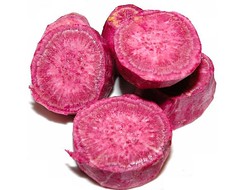 Peel off the skin and chop the yam into chewable pieces. Bring them to the boil for 15 mins with generous slices of ginger. Add a chunk of brown sugar, give it another 5 and it's done!
Peel off the skin and chop the yam into chewable pieces. Bring them to the boil for 15 mins with generous slices of ginger. Add a chunk of brown sugar, give it another 5 and it's done!In Chinese philosophy, we have yin to represent the female principle of the universe (dark and negative) and yang to do the male side (light and positive). That silent, delicate spectrum inbetween... I think we literally call it yam!
Labels: recipe
Friday, May 18, 2007
Thursday, May 17, 2007
Oh, oh deep water
Black and cold like the night
I stand with arms wide open
I've run a twisted line
I'm a stranger in the eyes of the Maker
I could not see for the fog in my eyes
I could not feel for the fear in my life
And from across the great divide
In the distance I saw a light
Jean Baptiste's walking to me with the Maker
My body is bent and broken
By long and dangerous sleep
I can't work the fields of Abraham
And turn my head away
I'm not a stranger in the hands of the Maker
Brother John, have you seen the homeless daughters
Standing there with broken wings
I have seen the flaming swords
There over east of Eden
Burning in the eyes of the Maker
Burning in the eyes of the Maker
Burning in the eyes of the Maker
Oh river rise from your sleep....
Words/Music: Daniel Lanois
Labels: sound
Saturday, April 28, 2007
Wednesday, April 25, 2007

Getting sufficient omega-3 has never been a problem for me. I eat fishes and leaves on a regular basis. Especially at the end of each week, there's always a fish on my dining table.
I've been eating fishes since, no, before I was born. My mum loves eating fish so much. Not a day has passed without a fish on her chopboard. When I was still a foetus, I must have been taking in a lot of omega-3. When I was a toddler, I used to play with the fishes mum bought home (in this part of the world, people prefer live fishes). When I was a kid, I started going to the wet market to get fishes for the family. When I was a teenager, I was doing most of mum's jobs. In
 short, this seemingly uninspiring creature means a good lot to me.
short, this seemingly uninspiring creature means a good lot to me.Here in Tung Chung, we have fresh catches from the surrounding waters and sold in the market everyday. Those who don't know where Tung Chung (東涌) is, it's a town in Lantau Island, not far from the international airport of Hong Kong. It was a fisherman's village back few decades ago, before the airport was built. Although it's an entirely different make-up now, if you travel a bit down west and south, you'll still see the old charms of Tung Chung and other parts of the Island.
This fish is one of the catches from this part of the sea. This time of the year, it's the best season for many species, especially the snappers. And this one, Lentjan (海連尖), roughly classified as a snapper family member, is my all-time favourite.
Bought live from the market here over the weekend. A few avid supporters of this blog would instantly know this creature has appeared here before. This fish is probably the most underrated species in the market. She never appears on restaurant's menu. She never draws the attention of the majority of the cooks. She is rarely barely on anyone's list. But, of course, to make her appearance here twice, she must possess a meaningful degree of charm.

Again, this fish was a live catch. I was able to do a bit of sashimi. And its size was big enough for me to add a few twists to an usual cooking recipe. Remember the "Pan-grilled Lentjan with a Double-lime Twist" back last August, I was using lime leaves, garlic, ginger and extra virgin olive oil as a marinate. Here, I kicked out the garlic, reduced the role of lime leaves and ginger and brought in the grass.
Let's see the ingredients, nothing extravagant:
1. two straws of lemongrass, remove the top and bottom parts and chop them finely; and
2. tiny bit of ginger and lime leaves, finely shredded;
Use a real sharp knife to slice off the meat from the fish (I had literally gone through a whole sharpening process). The meat was so super fresh. I made myself a small piece of sashimi. With a drop of soya sauce, it was gorgeously sweet. This act is not encouraged, however, as water in the wet market is most likely contaminated.
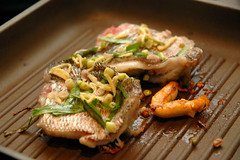
Okay, marinate the meat with lemongrass, lime leaves, ginger, extra virgin olive oil, 1/2 teaspoon of flour, sea-salt and fresh ground pepper (preferably a mix of white and black). Leave it for one hour.
Heat up the pan to a grilling temperature, with a few drops of oil. Toss the fish onto the pan. The skin side should be on top first. Leave it for 2 minutes, until it gets "toasted". Lower the heat a little. Turn over and give it another minute.
Give it some more fresh pepper and it's done! Sprinkle a few drops of extra virgin olive oil. Fresh lime juice is entirely optional. That night, I had the usual Chinese green, also from the local soil, to go with. Omega-3 never runs short, not on me.

With this fish and this recipe, I never bother to make a sauce. The ingredients are just enough to bring out the flavours of the fish while keeping its tenderness intact. When served with a fresh cut grass sauvignon blanc, the charm of this fish will start flirting with your taste buds. And you will forever be begging for more!
Labels: recipe
Tuesday, April 24, 2007
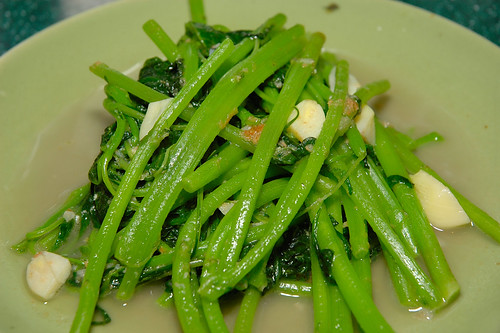
Labels: food science
Saturday, April 21, 2007
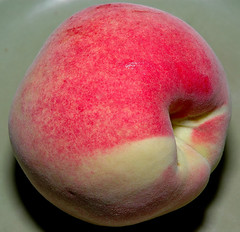 "Eat food. Though in our current state of confusion, this is much easier said than done. So try this: Don’t eat anything your great-great-grandmother wouldn’t recognize as food. (Sorry, but at this point Moms are as confused as the rest of us, which is why we have to go back a couple of generations, to a time before the advent of modern food products.) There are a great many foodlike items in the supermarket your ancestors wouldn’t recognize as food (Go-Gurt? Breakfast-cereal bars? Nondairy creamer?); stay away from these..."
"Eat food. Though in our current state of confusion, this is much easier said than done. So try this: Don’t eat anything your great-great-grandmother wouldn’t recognize as food. (Sorry, but at this point Moms are as confused as the rest of us, which is why we have to go back a couple of generations, to a time before the advent of modern food products.) There are a great many foodlike items in the supermarket your ancestors wouldn’t recognize as food (Go-Gurt? Breakfast-cereal bars? Nondairy creamer?); stay away from these..."Click here to read Michael Pollan's full article
Labels: food science
Saturday, April 14, 2007
 birds
birds sing
for
their
lives
Mornington Peninsula, Australia
On film, Nikon f801s
Music: Nine Horses
Lyrics/vocals: Stina Nordenstam
Wednesday, April 11, 2007
Note from Mirna
Hi Kevin
Thanks for the pic's. I like your website..
Your camera takes very sharp, good quality photos.
Fred and I got back to Melbourne on Sunday.
The names of the dishes are.
- Chickpea dip called 'Hommus'. This is the one you have the picture of, on your website.
- Eggplant dip called 'baba-gan-ouwgh'.
- Spinach dish with mince meat and some plain rice, next to this you serve natural yogurt which has garlic and salt in it to give the dish more flavour.
- Potato and meatballs called 'Kifta & Batato'. The Meat balls has the following ingredients, mince meat preferably lamb mince (I used beef mince when I cooked in Hong Kong) finely chopped parsley, finely chopped onion with salt and paper. The sauce is tomato paste and pomegranate concentrated paste mixed with a bit of water and salt and pepper to taste. Then you put sliced tomatoes on the top.
- Tabouli has finely chopped parsley (any Mediterranean or Italian parsley is fine, best not to use the continental parsley as this is too hard to chop up) finely chopped spring onion, finely chopped mint leaves, nicely chopped square pieces of tomatoes, buck-wheat, lemon juice, oil, salt and pepper.
- Potato dices with coriander, garlic, lemon and salt and pepper to taste.
I hope this helps for your website.
Hope to see you when I get back to Hong Kong, and this time, your turn to cook.
Talk to you later
Mirna
Great thanks, Mirna!
Thursday, April 05, 2007
لابانيسي يلة مع الاصدقاء والمطبخ
I can't wait. The holiday, or at least the mood of it, has been set in motion a week earlier. When Natty called me, I knew it was going to be another gorgeous home-dining experience. And I knew my cookware and everything else would have to give way to the challenge.
One thing I did't expect though. It wasn't the usual Thai dinner, which Natty Orranut Hiranmathakij is instinctively good at. It was, to my surprises, a gorgeous Arabian experience. (Natty is a beautiful friend of mine who, I still speculate, must have been Miss Thailand two decades ago.)

Natty's boyfriend Sam is an Australian living/working in Hong Kong for many years (arguably also, the most goodlooking pilot in this part of the world). He has an Lebanese ethnic origin. This holiday he had his family visiting. And I had the privilege to try out some of the best Lebanese family cookings.
This time Sam's sister, Mirna, took over the kitchen. The hard work began in the morning. Correct me if I'm wrong, Labanese food is closely associated with the Meditteranean. The parsley, the mint, the olive oil, the yogurt, the lamb, etc, etc. It was a huge task for her since the true ingredients are rarely available in Hong Kong.
When I got there, the eloquent Sam already started telling me stories of Lebanon. There were some that I'd heard and some that I hadn't. Anyway.
The area including modern Lebanon has been for thousands of years a melting pot of various civilizations and cultures. Originally home to the Phoenicians, and then subsequently conquered and occupied by the Assyrians, the Persians, the Greeks, the Romans, the Arabs, the Ottoman Turks and most recently the French, Lebanese culture has over the millennia evolved by borrowing from all of these groups.
The country has enjoyed only brief periods of relative calm. The Israeli's attack during the summer last year. The 15-year civil war that began in 1975, devastating the country massively. The Arab-Israeli war in 1948. In short, it's a country that has a lot of complexities and sensitivities, politically, ethnically and religiously. (That's all an unqualified historian can tell.)
Some of the most popular Lebanese dishes include Kibbeh—a lamb-and-cracked-wheat dish, often grilled or fried—and Tabbouleh, a salad made with cracked wheat, finely chopped parsley, tomato, onions and olive oil. This time, Mirna was making a couple of popular dishes. I have forgotten most of the names. But I remember I did have Tabbouleh (2nd pic of this post). We ate it with bread and fresh yogurt. Simple but absolutely beautiful. Besides the yogurt, Mirna prepared a special dipping made with beans which I cannot name (3rd pic). Those dippings already made my day!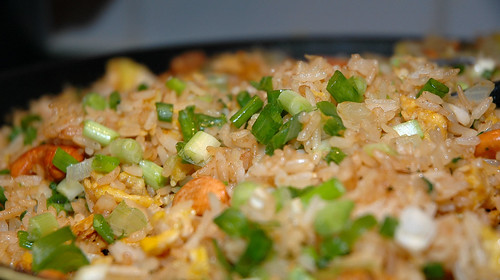
It wasn't a complete Lebanese dinner really. Natty made the chicken satay and some very nice Thai fried-rice with roast chestnuts. We were drinking Aussie and Kiwi wines, especially my favourite Marlborough Sauvignon Blanc. They all went perfectly well together. They were all mouth-wateringly beautiful!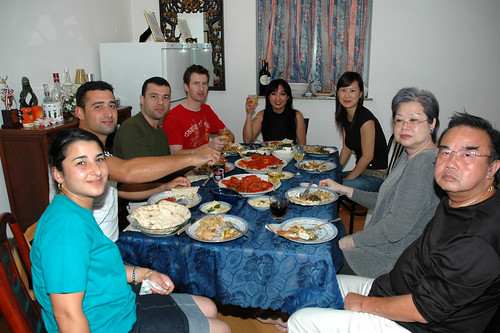
Tuesday, April 03, 2007
Saturday, March 31, 2007
Shaletown
On the blue-green rising, falling tide,
Breathing in the pebbles,
Sighing out the salt breeze.
Chaff is blowing from the stubble fields,
Leaving the dried earth land it threads the gate...
Tunnel hedges...
Old mans beard,
Sticking to the wild plums...
Old mans beard.
And follows the pot-holed tracks
That lead to Shaletown.
The ox-mans soul forever turns around
And ploughs the stubble field,
Caught in the lonely mile
Between the roads to Shaletown.
He watches the chaff leave his dry brown eye
And swing over rose-hip stile
To Shaletown.
Under bronze-red sunset, cobweb clouds,
Dipping to the shadows
Dancing through the dead trees,
Over carts that struggle up the hills
Sticking into the sweat and blistered hands...
Nailed sacks flap...
From blackened walls,
Flailing arms to welcome...
From blackened walls
Into the groaning heart of Shaletown.
The ox-man turns and walks into the wind,
Towards the ceaseless sea,
Ploughing the lonely mile
As chaff settles in Shaletown.
The machines they groan and the hammers they pound
As night falls on Shaletown
The chaff settles in Shaletown.
Words: Simon Huw Jones
Music: And Also The Trees
Labels: sound
Monday, March 19, 2007
Curse of the Golden Shrimps
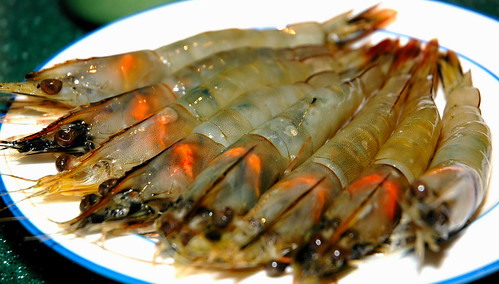
較早時候, 看過"滿城盡帶黃金甲"這齣戲. 一齣以皇朝宮廷作背景嘅電影, 當然有基本的權力、慾念和貪婪嘅元素.
整齣戲是這些東西穿穿插插, 在糾纏不清, 覺得有点悶納的時間, 那一刻, 在我腦裡, 竟想起這碟餸.
金黃香滑豐郁的外衣, 裡面卻是幼嫩甜美的蝦肉, 蝦頭裡也有金黃香濃的蝦羔. 咬它一口, 是慾望的投射, 是詛咒的伸延.

弄這口黃金蝦, 只用上三數样材料, 簡單不過. 也不消十數分鐘.
好, 先睇睇材料...
1. 適量海中蝦, 一定要海蝦, 養殖蝦不該出現;
2. 咸蛋黃兩個, 黃金的精髓就是從咸蛋黃而來;
3. 適量葱、紅辣椒(去核)、少許蒜, 全部砌碎備用.
先剪去蝦頭刺手的部份, 備用.
將咸蛋煮熟, 取黃, 再碎成粉狀. 將蝦混在蛋黃之中, 加少許鹽和胡椒粉.
強火起鑊, 將蒜爆一爆. 隨即放蝦, 將火弄低, 輕煎蝦的兩面, 大概每面兩分鐘. 最後放葱及辣椒, 輕炒多一分鐘, 即成!
吃蝦慣常會喝白酒, 但吃黃金蝦, 紅酒更為適合, Pinot Noir甚至是大紅Shiraz都可以.
在糾纏不清的時間, 總會把鑊鏟拿來. 黃金蝦的詛咒, 我心甘, 也情願噢!
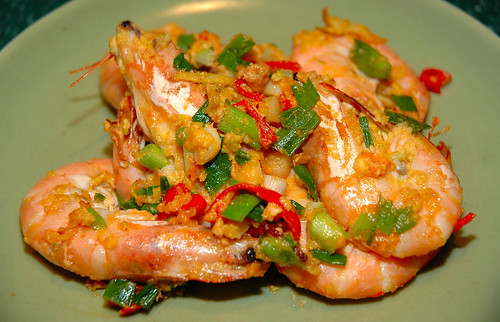
Labels: recipe
Wednesday, March 14, 2007
The Minimalist Cooking Celebrates Its First Anniversary
It’s been a year since. This blog was created on 14 March 2006.
It was meant to be a food blog. I have however abused this authority by stretching it a little far and beyond - music, lyrics, photos and plain nonsenses. This mix somehow seems to produce some flavours. I’m glad it has come this far here. Surviving, alive and kicking still. For this day there is every reason to celebrate.
The foods at this blog - the crabs, the basil, the okras, the shimeji, the melons, the tagliatelle and the like – all have a story of their own. Most of the recipes here were invented or improvised literally. There was someone who shared with me every bite of these foods. She was my reason to cook. She was my inspiration for new ingredients. Three weeks after this blog was created, she disappeared, vanished, in a puff of smoke.
For the following months, the blog and the blogger took a hiatus, not up and running until July. Arguably, its birthday should be another date in July.
I have found new inspirations to cook. I have found fresh flavours in my recipes. I have lived each season as it passed. I have learnt to resign myself to the influences of each.
And I’m so glad to have made a few friends along the way. This blog is a living blog. It wouldn't make much sense without you around. For this I thank you.
The Minimalist Cooking will continue to cook, to live, to learn and to love.
Sunday, March 11, 2007
My three other nephews. Taken during a school summer holiday in 1992. My hometown in China. The heat was intense, the glare was burning, as you can see from their faces. They were playing at the same spot I was playing when I was their age. They were catching the same summer beetles I was catching. The one on the right is the closest nephew. We look more alike, don't we? These kids of course are all grown-ups now.
This picture was shot on film with a Nikon F801s. The original print and negative have been kept surprisingly well, making this old picture look very young still.
Picture upload has been made easier and better with the new Blogger and the link functions of Flickr. More to come. Stay tuned!
Labels: sight
Monday, February 26, 2007

I know it’s just a matter of time I’ll be a vegetarian. I eat less and less meat these days. When I do have, it’s most often a light touch of seafood. Red meat has been a rare choice of my diet.
On a typical weekday, I can’t but reach out for lunch. The meat proportion is usually large. My stomach would be telling me “enough for today!”
So, back home cooking for dinner, I have developed a natural tendency to minimize the meat portion. It’s not unusual really that I would have a complete vegetarian diet. Besides, vegetables can be kept much longer than meat. It saves me the trouble of shopping regularly. As somebody who strives to cook dinner every working day but time is a major constraint, vegetables are my natural choice.
Here’s one I always do. Stir-fried eggs with Shimeji mushrooms. Yes, both eggs and mushrooms are classified as vegetarian. In Hong Kong, it’s popular to have stir-fried eggs with shrimps. The tenderness of the shrimps goes perfectly well with eggs. Here, I replace shrimps with my favourite Shimeji mushrooms (also known as Bunapi Shimeji, White Beech or White Clamshell).
The Shimeji should always be cooked, it is not supposed to serve raw. When raw, this creature has a somewhat bitter taste. The bittereness disappears when cooked. The cooked mushroom has a pleasant, firm, slightly crunchy texture and a delicious mildly nutty flavor.
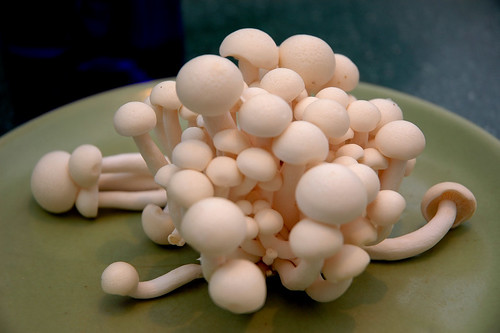 Ingredients:
Ingredients:1. a handful of white Shimeji mushrooms;
2. two eggs; and
3. spring onion, finely chopped;
Cut off the bottom unwanted part of the mushrooms. Rinse them slightly and leave dry. Stir the eggs hard and well, with a small pinch of sea salt.
Use a wok that can stand heat because the heat plays a vital role in this stir fry. Heat it up with four spoonfuls of oil. Throw in the mushrooms and stir-fry them well for about half a minute. Spread them slightly over the wok.
Then go the eggs and spread them around the mushrooms. Leave them alone for seconds so that eggs get slightly cooked. Pour the spring onion and stir fry everything well.
Fire off and instantly bring them to the plate to keep the tenderness intact.
With rice and Chinese green vegetables, it's a dinner that serves me well. I won’t ask for anything else. I won’t have any more complaints about the day. And I’ll be ready for another hard one coming.
Labels: recipe
Sunday, February 18, 2007
 Have you had an experience like this? A gorgeous one that you never forget. As if someone implanted a chip in your brain with a timer well set. Every now and then, the sound, the vision or the smell comes back to your memory. It brings it back for a moment but then you always have to let it go.
Have you had an experience like this? A gorgeous one that you never forget. As if someone implanted a chip in your brain with a timer well set. Every now and then, the sound, the vision or the smell comes back to your memory. It brings it back for a moment but then you always have to let it go.On this day, 13 years ago, I had this night. I went to see Cocteau Twins at Brixton Academy in London. Cocteau Twins is a legendary British rock icon that began their 17-year musical journey from the early-80s. Unequivocally my most favourite band. Brixton is the first place to name when it comes to gigs and concerts. Both were my first experience. So it was x2 special to me. I secured this ticket on the first day of bookings, anxiously waiting for the night to come. That night opened my eyes.
That night, they played this song "Pur". At last year's Cocteau Twins Essence Contest, one of the three winning submissions says...
"Pur is what we heard when we met, what we saw falling in love, what we felt saying," I do". It's what we tasted when we divorced. Ever now and again, when I hear that song come over my ipod, it brings it back for a moment but I always let it go."
 Pur is exactly the feeling I'm having now. I know it sounds just weird on this very Chinese New Year Day.
Pur is exactly the feeling I'm having now. I know it sounds just weird on this very Chinese New Year Day.And I know this blog is supposed to talk about food. Please excuse me again. I promise coming up next will be another mouth-watering piece. But, bear with me a little longer. Pur!
Lyrics
Tuesday, February 13, 2007
Phantasmagoria in Two
If a fiddler played you a song, my love
And if I gave you a wheel
Would you spin for my heart and loneliness
Would you spin for my love
If I gave up all of my pride for you
And only loved you for now
Would you hide my fears and never say
"Tomorrow I must go"
Everywhere there's rain my love
Everywhere there's fear
If you tell me a lie I'll cry for you
Tell me of sin and I'll laugh
If you tell me of all the pain you've had
I'll never smile again
Everywhere there's rain my love
Everywhere there's fear
I can plainly see that our parts have changed
Our sands are shifting around
Need I beg to you for one more day
To find our lonely love
Everywhere there's rain my love
Everywhere there's fear
Words/Music: Tim Buckley
Labels: sound
Saturday, February 10, 2007
Labels: flash
Wednesday, February 07, 2007
 The Purgative Experience
The Purgative Experience Yes, I was cheated.
And yes, it was oily, horribly oily!
click here to find out what this monster is...
Labels: flash
Friday, February 02, 2007
This blog has been short of soup. For one thing, it is something I’m not really good at. For another, good soup usually demands a lot of ingredients, time and attention. It is kinda against the minimalist principles here.
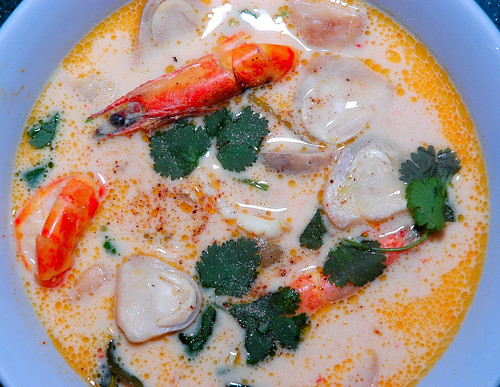 I've been taking some shots actually. Just didn't have a real good chance to bring them on. Tonight, a Friday night, is a nice quiet night. So here I am…
I've been taking some shots actually. Just didn't have a real good chance to bring them on. Tonight, a Friday night, is a nice quiet night. So here I am…Last Christmas, I had four great friends coming for dinner. Ling Ling (my newly adopted sister), Ray (my newly adopted brother-in-law, by default), Lam Lam and Zia (names tell, two sweet girls!). I don’t remember exactly. That night we had about six or seven courses. Salad, soup, entrée, main and main again. Champagne, wine and more wine.
OK, it’s the soup. Yes, I think the highlight of the night was the soup, at least in terms of time and effort I put in. So I am singling it out and bringing it here.
Tom Kha Gai is a mild but spicy chicken soup, with the very unique flavour of galangal ("kha" in Thai) which creates a heavenly taste when combined with hot chilli, coconut milk, lime leaves and lemongrass.
 To make it a little more special for the occasion, I added a different twist by introducing shrimps and squids.
To make it a little more special for the occasion, I added a different twist by introducing shrimps and squids.Not-quite-minimalist ingredients:
half a litre of chicken broth;
6-8 kaffir lime leaves, shredded;
6 or 8 1-inch pieces of fresh lemongrass, bruised slightly to release flavour;
1-inch cube (or a bit more) of galangal (also known as blue ginger), sliced thinly;
4 tablespoons of good-quality fish sauce;
2 tablespoons of fresh lime juice;
a whole piece of chicken breast, cut into smallish bite sized pieces;
half a dozen of shrimps, shells removed and slice-opened at the top;
a piece of large squid, cut thinly;
a bunch of straw mushrooms, sliced into halves;
250-500 ml of coconut milk;
small red Thai chillies, slightly crushed (to taste); and
coriander (cilantro) leaves to garnish.
 The number of chillies is a personal choice. It can be as few as three/four to more than a dozen. But the soup should retain a balance of flavours and not be overwhelmed by the chillies.
The number of chillies is a personal choice. It can be as few as three/four to more than a dozen. But the soup should retain a balance of flavours and not be overwhelmed by the chillies.The broth should be made with fresh chicken. Canned broth finds no place here. Filter it clear, please.
Heat the broth, add the lime leaves, lemongrass, galangal, coriander stems, fish sauce, salt and lime juice. Stir thoroughly, bring to a boil, and add the chicken, shrimps, squid, straw mushrooms and coconut milk, then the chillies.
Bring back to the boil, lower the heat to keep it simmering and cook for about 2 minutes (until the chicken, shrimps and squid are cooked through).
Garnish with a generous amount of coriander leaves. Sprinkle some fresh ground pepper.
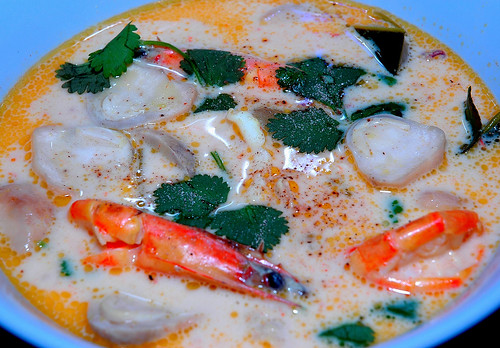
Not really intended to be eaten as a separate course, I like it served over a bowl of steamed jasmine rice. But, that night, we were served with salad and bread.
What a night! What a beautiful festive night!
Labels: recipe
